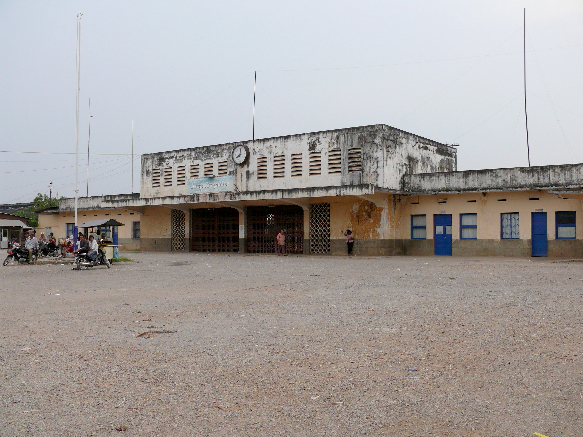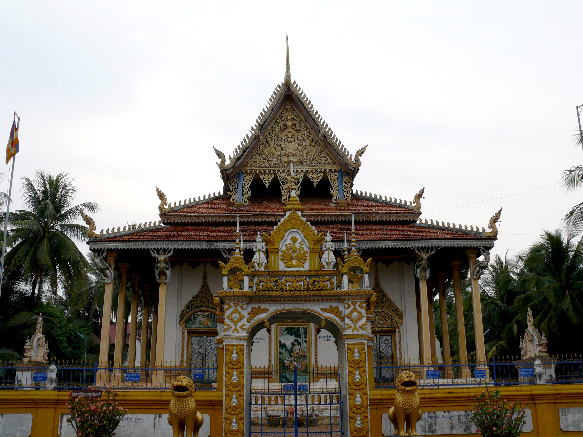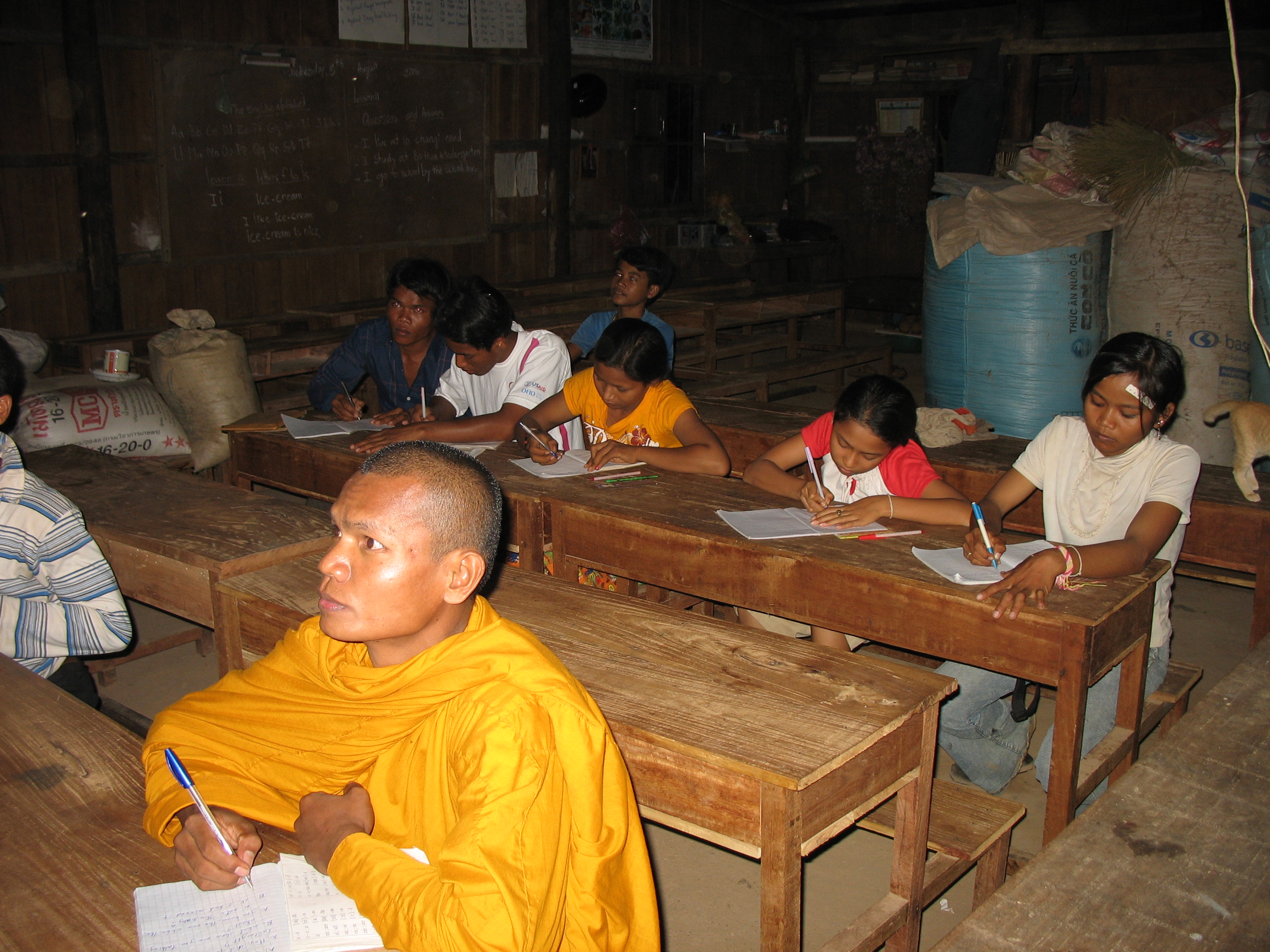|
Battambang Royal Railway Station
Battambang Royal railway station is a railway station in Battambang, the capital city of Battambang province in northwestern Cambodia. It was opened in 1953 and is operated by Royal Railways of Cambodia (''Chemins de Fer Royaux du Cambodge''). Location The station and its rail tracks are at the Phnom Penh– Poipet(–Bangkok) line at the west side of the town Battambang in Battambang province. Buildings The station building is well preserved and was repainted after taking the track out. The clock above the entrance stands still at 8:02 o'clock since an unknown day. As of January 2018 the rail tracks are being replaced. Beyond them, there are ruined remains of warehouses, signal boxes and rolling stock. Although dilapidated, some of them are use for living, storage or business. [...More Info...] [...Related Items...] OR: [Wikipedia] [Google] [Baidu] |
Battambang
Battambang ( km, បាត់ដំបង, UNGEGN: ) is the capital of Battambang Province and the third largest city in Cambodia. Founded in the 11th century by the Khmer Empire, Battambang is the leading rice-producing province of the country. For nearly 100 years it was a major commercial hub and provincial capital of Siamese province of Inner Cambodia (1795-1907), though it was always populated by Khmer, with some ethnic Vietnamese, Lao, Thai and Chinese. Battambang remains the hub of Cambodia's northwest, connecting the region with Phnom Penh and Thailand. The city is situated on the Sangkae River, a tranquil, small body of water that winds its way picturesquely through Battambang Province. As with much of Cambodia, French Colonial architecture is a notable aspect of the city, with some of the best-preserved examples in the country. Now the government and Ministry of Culture and Fine Art are preparing documents to nominate The Old Town of Battambang in the list of UNESC ... [...More Info...] [...Related Items...] OR: [Wikipedia] [Google] [Baidu] |
France
France (), officially the French Republic ( ), is a country primarily located in Western Europe. It also comprises of Overseas France, overseas regions and territories in the Americas and the Atlantic Ocean, Atlantic, Pacific Ocean, Pacific and Indian Oceans. Its Metropolitan France, metropolitan area extends from the Rhine to the Atlantic Ocean and from the Mediterranean Sea to the English Channel and the North Sea; overseas territories include French Guiana in South America, Saint Pierre and Miquelon in the North Atlantic, the French West Indies, and many islands in Oceania and the Indian Ocean. Due to its several coastal territories, France has the largest exclusive economic zone in the world. France borders Belgium, Luxembourg, Germany, Switzerland, Monaco, Italy, Andorra, and Spain in continental Europe, as well as the Kingdom of the Netherlands, Netherlands, Suriname, and Brazil in the Americas via its overseas territories in French Guiana and Saint Martin (island), ... [...More Info...] [...Related Items...] OR: [Wikipedia] [Google] [Baidu] |
Norry
A norry or nori ( km, ណូរី, , from the French word for lorry) was an improvised rail vehicle service from Cambodia. Lonely Planet describes it as "Cambodia's bamboo train". The trains ran at speeds of up to on the metre gauge tracks around Battambang and Poipet. A scheduled service ran by the Government also operates, but is slower at . The rest of the network, originally built by the French colonial government, is largely abandoned, after the Khmer Rouge regime effectively shut it down. In 2006 the BBC reported that there was only one scheduled service a week and it ran at not much more than walking pace. By October 2017 the bamboo train was no longer available in the original form due to the resumption of rail service between Poipet and Phnom Penh. However, the bamboo train was rebuilt near Wat Banan in order to cater to the local tourism industry. The relocated site opened in the middle of January 2018. Origins Norries had low fares, and were frequent and re ... [...More Info...] [...Related Items...] OR: [Wikipedia] [Google] [Baidu] |
Bamboo Railway At Battambang - Panoramio
Bamboos are a diverse group of evergreen perennial flowering plants making up the subfamily Bambusoideae of the grass family Poaceae. Giant bamboos are the largest members of the grass family. The origin of the word "bamboo" is uncertain, but it probably comes from the Dutch or Portuguese language, which originally borrowed it from Malay or Kannada. In bamboo, as in other grasses, the internodal regions of the stem are usually hollow and the vascular bundles in the cross-section are scattered throughout the stem instead of in a cylindrical arrangement. The dicotyledonous woody xylem is also absent. The absence of secondary growth wood causes the stems of monocots, including the palms and large bamboos, to be columnar rather than tapering. Bamboos include some of the fastest-growing plants in the world, due to a unique rhizome-dependent system. Certain species of bamboo can grow within a 24-hour period, at a rate of almost an hour (equivalent to 1 mm every 90 seco ... [...More Info...] [...Related Items...] OR: [Wikipedia] [Google] [Baidu] |
Sisophon
Serei Saophoan ( km, សិរីសោភ័ណ, Romanization of Khmer#UNGEGN, UNGEGN: ; lit. 'Beautiful Freedom') is the capital and largest city of the Banteay Meanchey Province and the fourth most populous city in Cambodia. The city separates Cambodia's National Highway 5 (Cambodia), National Highway 5 and National Highway 6 (Cambodia), National Highway 6. Its administrative name is "Serei Sophon" as used by the government. The more commonly used name Sisophon is derived from the Thai pronunciation ''Si Sophon'' when it was under the Thai rule. Another nickname "Svay" is used mainly by truck drivers, train drivers and workers transporting goods. The origin of the word "Svay" is unknown. Its population is 61,482 in the 1998 census, changing little to 61,631 in the 2008 census having been overtaken by Poipet in size.http://www.citypopulation.de/Cambodia.html Citypopulation.de Cambodia About forty minutes from Sisophon there is a Khmer temple ruin called Banteay Chmar. ... [...More Info...] [...Related Items...] OR: [Wikipedia] [Google] [Baidu] |
Moung Ruessei
Moung Ruessei is a small town and seat of Moung Ruessei District in Battambang Province, central-western Cambodia Cambodia (; also Kampuchea ; km, កម្ពុជា, UNGEGN: ), officially the Kingdom of Cambodia, is a country located in the southern portion of the Indochinese Peninsula in Southeast Asia, spanning an area of , bordered by Thailan .... The town is connected to Svay Don Kêv several kilometres to the east via the National Highway 5. Highway 149 connects it to Phumi Sakor in the north. {{Cambodia-geo-stub Towns in Cambodia Moung Ruessei District Populated places in Battambang province ... [...More Info...] [...Related Items...] OR: [Wikipedia] [Google] [Baidu] |
Pursat
Pursat ( ; km, ពោធិ៍សាត់, ) is the capital of Pursat Province, Cambodia. Its name derived from a type of tree. It lies on the Pursat River. The city is famous as the place of mythical 16th century ''neak ta'' of Khleang Moeung Ta Pech, Khleang Moeung or Sena Moeung, or ''Ghlāṃṅ Mīoeṅ'' is a mythical-historical sixteenth century military leader in Cambodia, and a guardian spirit ''neak ta'' whose field of action extends to the entire west of Tonle Sap Lake. Et .... Notes Provincial capitals in Cambodia Cities in Cambodia Populated places in Pursat province {{Cambodia-geo-stub ... [...More Info...] [...Related Items...] OR: [Wikipedia] [Google] [Baidu] |
Khmer Rouge
The Khmer Rouge (; ; km, ខ្មែរក្រហម, ; ) is the name that was popularly given to members of the Communist Party of Kampuchea (CPK) and by extension to the regime through which the CPK ruled Cambodia between 1975 and 1979. The name was coined in the 1960s by then Chief of State Norodom Sihanouk to describe his country's heterogeneous, communist-led dissidents, with whom he allied after his 1970 overthrow. The Khmer Rouge army was slowly built up in the jungles of eastern Cambodia during the late 1960s, supported by the North Vietnamese army, the Viet Cong, the Pathet Lao, and the Chinese Communist Party (CCP). Although it originally fought against Sihanouk, the Khmer Rouge changed its position and supported Sihanouk on the advice of the CCP after he was overthrown in a 1970 coup by Lon Nol who established the pro-American Khmer Republic. Despite a massive American bombing campaign (Operation Freedom Deal) against them, the Khmer Rouge won the Cambodian C ... [...More Info...] [...Related Items...] OR: [Wikipedia] [Google] [Baidu] |
Cambodian Civil War
The Cambodian Civil War ( km, សង្គ្រាមស៊ីវិលកម្ពុជា, Romanization of Khmer#UNGEGN, UNGEGN: ) was a civil war in Cambodia fought between the forces of the Communist Party of Kampuchea (known as the Khmer Rouge, supported by North Vietnam and the Viet Cong) against the government forces of the Kingdom of Cambodia (1953–1970), Kingdom of Cambodia and, after October 1970, the Khmer Republic, which had succeeded the kingdom (both supported by the United States and South Vietnam). The struggle was complicated by the influence and actions of the allies of the two warring sides. North Vietnam's People's Army of Vietnam (PAVN) involvement was designed to protect its Base Areas and sanctuaries in eastern Cambodia, without which it would have been harder to pursue its military effort in South Vietnam. Their presence was at first tolerated by Prince Norodom Sihanouk, Sihanouk, the Cambodian head of state, but domestic resistance combined with Chi ... [...More Info...] [...Related Items...] OR: [Wikipedia] [Google] [Baidu] |
Artillery
Artillery is a class of heavy military ranged weapons that launch munitions far beyond the range and power of infantry firearms. Early artillery development focused on the ability to breach defensive walls and fortifications during sieges, and led to heavy, fairly immobile siege engines. As technology improved, lighter, more mobile field artillery cannons developed for battlefield use. This development continues today; modern self-propelled artillery vehicles are highly mobile weapons of great versatility generally providing the largest share of an army's total firepower. Originally, the word "artillery" referred to any group of soldiers primarily armed with some form of manufactured weapon or armor. Since the introduction of gunpowder and cannon, "artillery" has largely meant cannons, and in contemporary usage, usually refers to shell-firing guns, howitzers, and mortars (collectively called ''barrel artillery'', ''cannon artillery'', ''gun artillery'', or - a layman t ... [...More Info...] [...Related Items...] OR: [Wikipedia] [Google] [Baidu] |
World War II
World War II or the Second World War, often abbreviated as WWII or WW2, was a world war that lasted from 1939 to 1945. It involved the vast majority of the world's countries—including all of the great powers—forming two opposing military alliances: the Allies and the Axis powers. World War II was a total war that directly involved more than 100 million personnel from more than 30 countries. The major participants in the war threw their entire economic, industrial, and scientific capabilities behind the war effort, blurring the distinction between civilian and military resources. Aircraft played a major role in the conflict, enabling the strategic bombing of population centres and deploying the only two nuclear weapons ever used in war. World War II was by far the deadliest conflict in human history; it resulted in 70 to 85 million fatalities, mostly among civilians. Tens of millions died due to genocides (including the Holocaust), starvation, ma ... [...More Info...] [...Related Items...] OR: [Wikipedia] [Google] [Baidu] |







